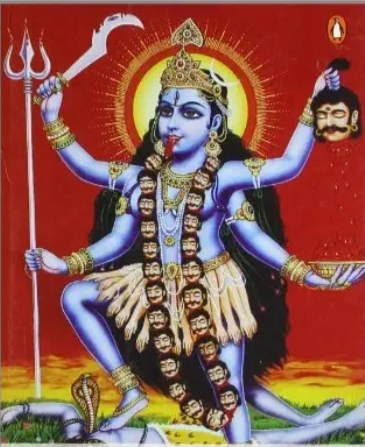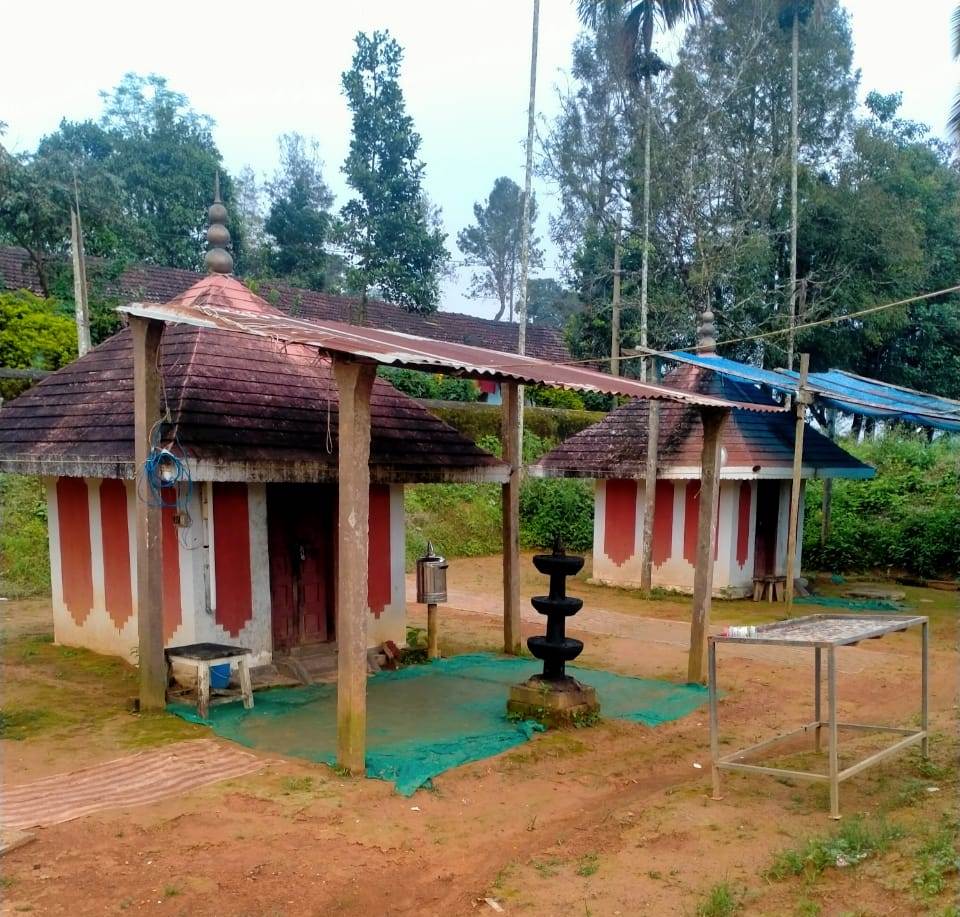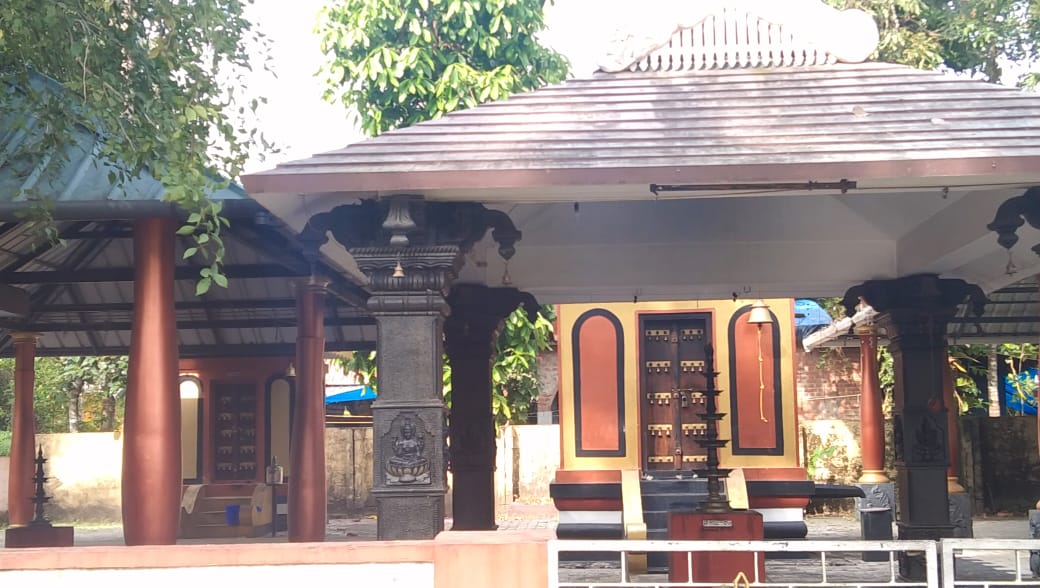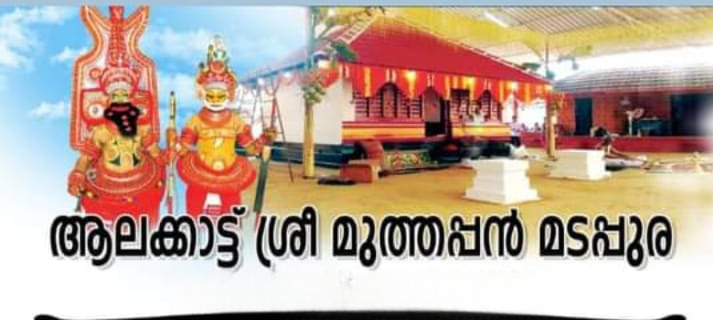As Per Sri Babaji’s Sankalpa, the first temple for Sri Subrahmanya (Lord Murugan) was constructed at the ashram premises in Sreekrishnapuram, Palakkad district. The sanctum sanctorum houses Sri Shanmugha Subrahmanya (six-faced) mounted on a peacock, flanked on either side His consorts Sri Valli and Sri Devasena. An idol of Lord Ganapathi and Sri Bhuvaneshwari is consecrated in the same sanctum sanctorum to the right and left of Sri Subramanya idol, respectively.
Ananta Koti Pranams are offered at the Lotus Feet of our beloved Sadhguru Sri Sharavana Babaji who bestows peace and tranquility to millions of devotees all over the world. Welcome to Sreekrishnapuram Sharavanabhava Matam, Palakkad, the headquarters of Shree Sharavana Baba Foundation that runs its operations in India and over 36 countries globally.
The 11th of October 1979 marks the birth of Sadhguru Sri Saravana Babaji as the the eighth son of Sri Lakshmi Ammal and Late Sri Krishnan Kutty Guptan in this holy land of Sreekrishnapuram. Recognizing his birth mission at the age of 20, Babaji
established the Sharavanabhava Matam for the welfare of the entire universe in
2002, and official operations started following registration in 2005. Today,
Sharavanabhava Matam offers its services in most of the cities in India. Besides the
“Mahakshethra” at Sharavanabhava Matam in Sreekrishnapuram, Babaji has
established the “Shree Jnaana Dhandayuthapaani Swamy Temple” in Kozhikode and the “Navagraha Sri Kathirgama Yogi Yogeshwara Yoga Dandayuthapani Swami
Temple” in London, the first of its kind abroad, where rituals are performed
according to the unique customs and tradition of Kerala.
Let us get acquainted with the “kshetra sankalpas” (temple concepts), worship
practices, rituals and service activities at Sreekrishnapuram Sharavanabhava Matam,
which functions under the auspices of the Shree Sharavanababa Foundation.
“Paalathara” and the “Dharma Devathas”
The Welcome Gate of Sharavanabhava Matam is barely 100 metres away from the
Village Office situated on Thiruvazhiyode-Aryambavu Road in Sreekrishnapuram
Panchayat. Once you get past the entrance, you will find the “Paalathara” on your
right side that houses the Dharma Gods and the family deities. It is imperative to
offer prayers and get permission from the deities to enter into the matam.
Babaji's Birthplace
As you alight the steps of Paalathara, on to your left side, you can see the renovated
house where Babaji was born and raised. There are two pooja rooms in this house
that commemorates “Sankalpa Prathishta” - the concepts worshipped by Babaji’s
ancestors consecrated in the first room and the concepts worshipped by Babaji in His early years consecrated in the second room. Offer your respects and prayers here.
Blessed Wormwood
As you head to the matam, you will see a “kaanjira maram” (wormwood tree) on to
your right before the Temple Ticket Counter. The beautiful idol of Shirdi Sai Baba
brought down from Shirdi, which is enshrined in the Sai Mandapam, was first placed
under this wormwood tree. Babaji had prophesied that the leaves of this wormwood
tree would be sweetened on that particular day every year to commemorate the
auspicious day.
Ticket Counter
The ticket counter facilitates booking of various poojas and offerings, from where
you can obtain the respective materials and receipts. After washing your hands and
feet in front of Ganapati Mandapam, enter the mandapam with wholehearted
devotion and chanting of holy names. once you have registered your names here,
you may start your divine darshan.
Ganapati Mandapam
This is the hall dedicated to Lord Ganapathi and the guardian deity Lord Bhairava
where yajnas like Maharudrayagam and Chandikahomam have been conducted for
many years. The special ritual of breaking coconuts after waving around oneself for
the removal of obstacles in one’s life is performed in front of the Lord Mahaganapati
seen first on the left side. “Karukamala” and “Ganapati Pooja” are some of the
special offerings made here. “Kalavara” (pantry) filling ceremony also happens in
front of Lord Ganapathi. “Annadhaanam” happens at the matam three times a day
throughout the year. You can bring as much ingredients as possible and offer them in the “Urli.” This special ceremony helps to alleviate poverty and acquire abundant
wealth.
Saraswati Mandapam
Saraswati Mandapam was inaugurated by the veteran carnatic musician
V.Dakshinamoorthy Swamy in 2013. Worship in front of the “Jnana Jyoti Kedavilakku -
the “Akhanda Jyoti,” which Babaji lit during the inception of the matam, envisaging
all the thirty three crore deities. It is the experience of many staunch devotees that
Babaji hears their prayers when they imagine whatever they would wish to say
directly to Babaji and pray in front of this lamp. The oil for this candle can also be
offered by the devotees. The idols of Durga, Lakshmi and Saraswati deities, after
being worshipped at Sri Mookambika Temple, Karnataka, were carried in a “Ratha
Yatra” (Chariot Festival) to Sreekrishnapuram Sharavanabhava Matam. The Mother
Goddess Saraswati is enshrined in this mandapam. Auspicious ceremonies like
“Vidyarambam” and seeking the deity’s blessings for all art forms are remarkable.
Babaji's “Paduka” and “Peetam” can be seen in this mandapam; offer your respectful
prayers. The sculptural charms of the Saraswati Mandapam are worth paying
attention to. Each pillar in this hall is adorned with deities like “Dakshinamoorthy,”
“Jnanaswaroopamurugan” and various “bhavas” (expressions) of Ganapati and Devi.
This is the hall where constant chanting takes place regularly.
Kalyana Subrahmanya Swamy Temple with Valli Devasena
There are 18 sacred steps representing 18 “tattvas” to enter the Kalyana
Subrahmanya Swamy Temple where the presiding deity Lord Subrahmanya is
in the guise of Thiruparankundram Subrahmanya Swamy. Touch and worship
the steps as you climb them. The auspicious “Padi Puja” can be made as an
offering. After worshipping the zodiac above, worship the peacock, the vehicle
of Lord Subrahmanya, in front of you. The sanctum sanctorum houses the six-
faced Sri Shanmugha Subrahmanya Swamy on a peacock with His consorts Sri
Valli and Sri Devasena on either side. Lord Ganapathi and Sri Bhuvaneshwari
are also consecrated in the same sanctum sanctorum to the right and left of
Sri Subrahmanya Swamy. “Jataka Puja” is a very special ritual performed here
to remove the obstacles related to marriage, rectify the unfavourable flaws in
horoscopes and for bestowing long life to married couples. The horoscope is
placed at the feet of Lord Subrahmanya in this temple on a full moon day after
9.30 am and collected after a “Mandala Kaalam” (41 days) . Many families
have benefited from this pooja and are leading their married lives happily.
“Paalabhishekam” and “Panchamrith Abhishekam” are very special. “Paalpaayasam”
can be offered on Full Moon, Sashti and New Moon days. Offering silk to Bhuvaneshwari Devi is remarkable. While performing “pradakshina” around the sanctum sanctorum of the Kalyana Subrahmanyaswamy Temple, you can see the sculptures of Lord Muruga in various “bhavas” as depicted in His six abodes. After having “darshan” of the “Arupadai Veedu Muruga,” you can enter the Sai Mandapam.
Sai Mandapam
The darshan in the Sai Mandapam begins with the Ardhanareeswara worship. After having darshan of Sri Rama-Lakshmana-Sita-Anjaneya, worship Sankaranarayanaswamy, bow down to Dattatreya Swamy and enter the Shirdi Sai Mandapam by ringing the temple bell. Worship the charming idol of Shirdi Sai Baba
brought from Shirdi. After prayerfully worshipping at the Guru Mandapam of Paramahamsa Yogananda, Durga Mandapam and Sastha Mandapam, light
an“Elluthiri” lamp in front of Lord Ayyappa to ward off the malefic effects of Lord
Saneeshwara. Then bow down to the 18 “Siddhars” of Tamil tradition. “Siddha Puja”
is a special ritual performed every Thursday and can be booked in advance. After
offering respects at the mandapam where the worship items used by Babaji during
His “Upasana” times are treasured, proceed towards worshipping the 7-feet
MahaShivalingam, which specifies the “Sahasrara Padma” above the 6 chakras in our body. The Shiva Pooja performed every Monday is very special. Shiva Pooja, along with “Koovalamala” can be performed as a special offering. During Maha Shivratri festival,the Maha Abishekam” is performed here during the “Eight Kala” poojas.
Then proceed to the Anjaneya Mandapam where you can offer “Betel Leaves
Garland”. Worship the “paduka” of Lord Sathya Sai Baba blessed by Baba Himself to
be handed over here through a dream revelation. After worshipping the “Sri Chakra
Mahameru,” bow down reverentially to Shirdi Baba, the “Tapomurthi” for whom the
poojas are performed in the North Indian style. Then bow down to Lord Vishnu on
the left and reach the Lakshmi Mandapam ahead.
Lakshmi Mandapam
This is the mandapam inaugurated in 2013 by Babaji's highly regarded and adorable
mother Lakshmi Amma. The idol of Mahalakshmi is placed in front of the idol of
“Annapoorneshwari”. Pray for the alleviation of grief and poverty. Worship the
“Ashtalakshmi” and “Dashavatara” forms engraved on each pillar and rest for a while.
Remember Babaji who brings peace and tranquility to everyone, irrespective of caste,
religion, tribe or colour and meditate on HIM. The different towers that symbolize
interfaith harmony constructed above the Lakshmi Mandapam is noteworthy.
Guru Peetam
Go down the 18 steps in front of the Shirdi Sai Mandapam, go around the Saraswati
Mandapam and climb up to the Dakshina Murthy Temple called Guru Peetam on the
left side. This is one of the rare temples dedicated to the “Adi Guru,Dakshinamurthy”. Ghee lamps, “Sri Rudra Dhara”, “Ilaneer Dhara”, other abishekams
and special offerings to please the deity can be performed. It is very good to perform
worship by offering “Thamboolam.” “Kumkuma Archana” is also performed for Sri
Chakra Mahameru. On “Pournami” days, the full moon pooja is performed under the
guidance of the temple “tantris.” Pournami Pooja can be performed as a special
offering. It is very auspicious to perform the “Birthday Homam” on one’s birthday.
Saravanabhava Matam “Thiru Naagakkavu”
Heading your way to the Ganapati Mandapam, you will see the entrance to the
Snake Temple. One must enter this highly powerful and dynamic temple with utmost
purity. It is mandatory to observe complete silence here. One can offer turmeric
powder and oil, praying for eradication of the malefic effects of “Naga Dosha.”
Special poojas are conducted on the day of “Ayilyam Nakshatra” to please the
serpent gods. Couples without children can perform this pooja regularly for blessings
to have children. Beside this temple, construction of “BhugarbhaLingeswara Temple”
and “Nakshatravanam” projects are in progress. As you go down the stairs, you can
see the medicinal tree “Murukanjiram” on the right side. Once you reach the
Ganapati Mandapam, you will see the “Balabhadra Theertha Kulam” in the field just
in front of you where preparations for the consecration of Goddess Balabhadra are
in progress. After thanking all the deities, touching the soil filled with Babaji’s grace
reverentially and getting permission from the guardian deity “Lord Bairava,” you can
make your way back home.
Sharavanabhava Matam Goshala
The “Goshala” is one of the highlights here. If you walk a little further from the Naga
Temple, you can see the “Goshala.” The cows are very well cared for here. You can
also donate essential items needed for the cows. It is mandatory to get the receipt
for the offerings.
Theertha Kulangal
The “Cauvery Theertham” is a holy place where water is always available for all the
needs of the Matam. Many ailments have been cured by drinking this holy water.
Similarly, Lakshmi Theertham is maintained with divine concepts. Shiva Ganga
Theertham is used to purify the body. In addition, conservation of water resources
like wells and other ponds are also being executed by the Matam.
Other facilities at the Matam
Buildings like “Sree Kailasam” and “Sree Paadam” for the accommodation of the
devotees,“Sachidananda Auditorium” for weddings and other public functions, and
“Annapoorneshwari Oottupura” for “Annadhaanam” purposes are very well
constructed and open to the public.
Festivals and Celebrations
Shivaratri,Thaipooyam, Navaratri and Guru Purnima are celebrated as great festivals.
Babaji's birthday is celebrated in a glorious manner. Various other rituals are
performed in an exemplary manner. In addition to the daily poojas, there are special
poojas and homas on special occasions, as well as “Thulabharam” and “Choroonu”.
“Akhanda Nama Japam” on the first Sunday of every Malayalam month, “Lalitha
Sahasranama Samooha Kudumba Aishwarya Pooja” on the second Saturday of each
English month, “36 uru Subramanya Ashtothra Japa” on Sashti day of “Velutha
Paksha”,“Subramanya Sahasranama Archana” every Tuesday and “Vishwa Shanti
Prarthana” at 9 am everyday are performed here. Spiritual discourse camps are also
conducted on certain days. Babaji's birthday is celebrated with numerous charitable
and service activities.
Prasadam will be sent by post, especially to those who are unable to attend the
poojas directly. Receipts for special poojas must be acquired in advance. Bookings
for offerings can also be made via money order, cheque, demand draft and account
transfer and are to be confirmed via telephonic call. Shree Sharavanababa
Foundation demonstrates exemplary work through various service and charitable
activities. Recognising the needs of the community, Sharavanabhava Matam does a
lot of selfless service in a timely manner. Besides medical aids, self-employment and
housing assistance, medicine and “Annapurna Samridhi Kit” distribution to the needy,
learning materials are provided to more than 25,000 children every year.
Sree Saravana Baba Seva Samiti
Sri Saravana Baba Seva Samiti ,a voluntary group comprising of men and women,
works towards regeneration of a new society that is selflessly committed to
community service, embracing the ideals of Babaji. The daily activities, festivals and
service activities of the matam are carried out by this committee. Those who are
interested in becoming a member of this group can contact the office.
Sri Sharavana Babaji who travels globally through the Shadakshara mantra “Om
Sharavana Bhava” and grants peace and tranquility to everyone is regarded as
“Sadhgurunath.” To get to know more about Babaji and understand Babaji’s
ideologies and work together, you are sincerely and cordially invited once again to
visit Sharavanabhava Matam.
Om Sharavana Bhava




No Events for next 2 days